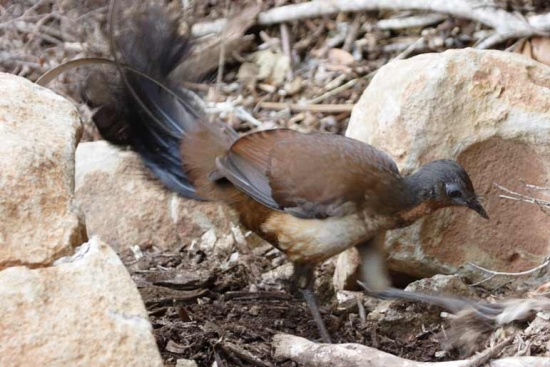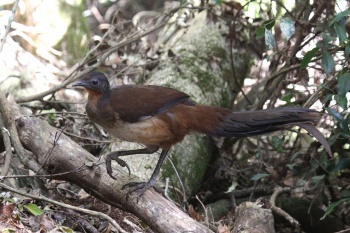Alternative name: Prince Albert's Lyrebird
- Menura alberti
Identification
Approximately 86–93 cm (33¾-36½ in)
- Long legs
- Strong clawed feet
- Train-like tail
Male
- Dark grey head and neck
- Reddish-brown upperparts
- Chestnut underparts
Similar Species
Lacks the lyre-shaped tail feathers of the Superb Lyrebird.
Distribution
Endemic to Australia, in a small area on the state border between New South Wales and Queensland.
Taxonomy
This is a monotypic species[1].
Habitat
Subtropical rainforests and wet sclerophyll forests with dense undergrowth.
Status
Classed as Vulnerable on the IUCN Red List of Threatened Species due to ongoing habitat loss.
Behaviour
It is very similar to the Superb Lyrebird in its habits.
Breeding
They build platforms by trampling down dense vegetation for courtship display. They lay their eggs from May to August, but there is little other information.
Diet
The diet is thought to consist mainly of insects, both adult and larvae, in addition to some invertebrates found in the soil.
Vocalisation
This bird mimics other species sounds.
Lamington National Park, Australia, July 2009
Recorded by Andrew Whitehouse
References
- Clements, J. F., T. S. Schulenberg, M. J. Iliff, D. Roberson, T. A. Fredericks, B. L. Sullivan, and C. L. Wood. 2017. The eBird/Clements checklist of birds of the world: v2017, with updates to August 2017. Downloaded from http://www.birds.cornell.edu/clementschecklist/download/
- Handbook of the Birds of the World Alive (retrieved Dec 2017)
- Wikipedia
Recommended Citation
- BirdForum Opus contributors. (2025) Albert's Lyrebird. In: BirdForum, the forum for wild birds and birding. Retrieved 29 April 2025 from https://www.birdforum.net/opus/Albert%27s_Lyrebird
External Links
GSearch checked for 2020 platform.





